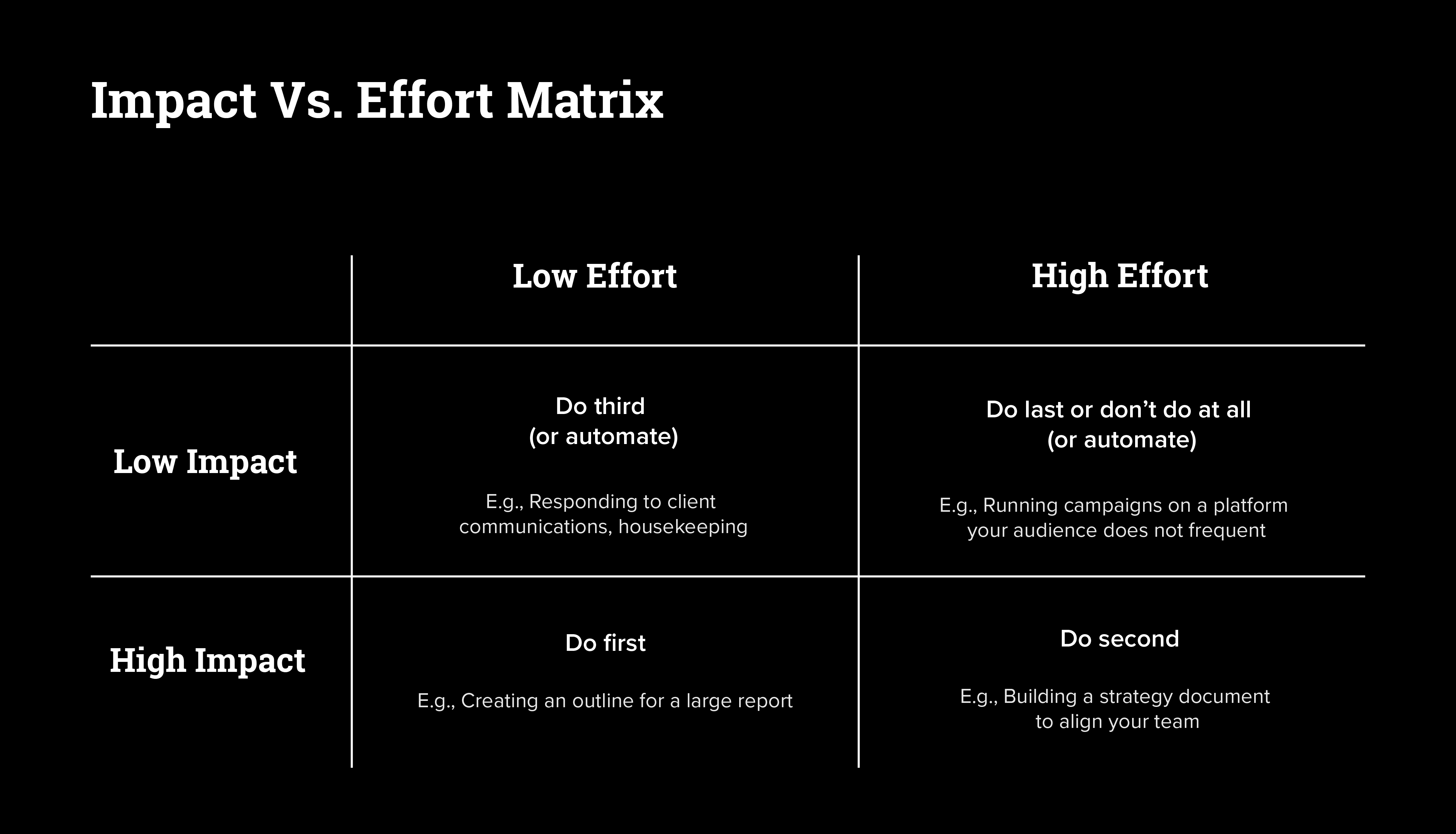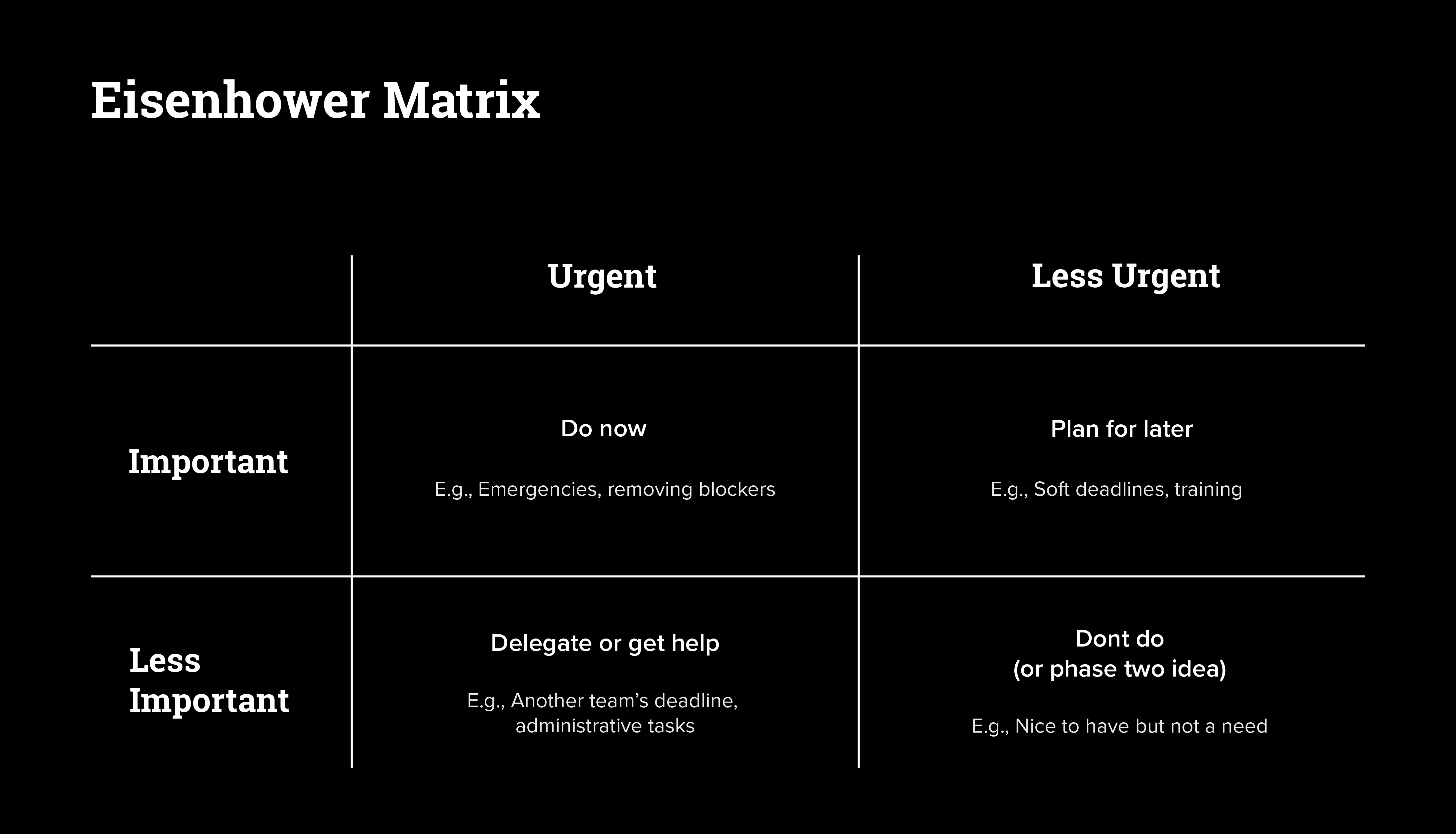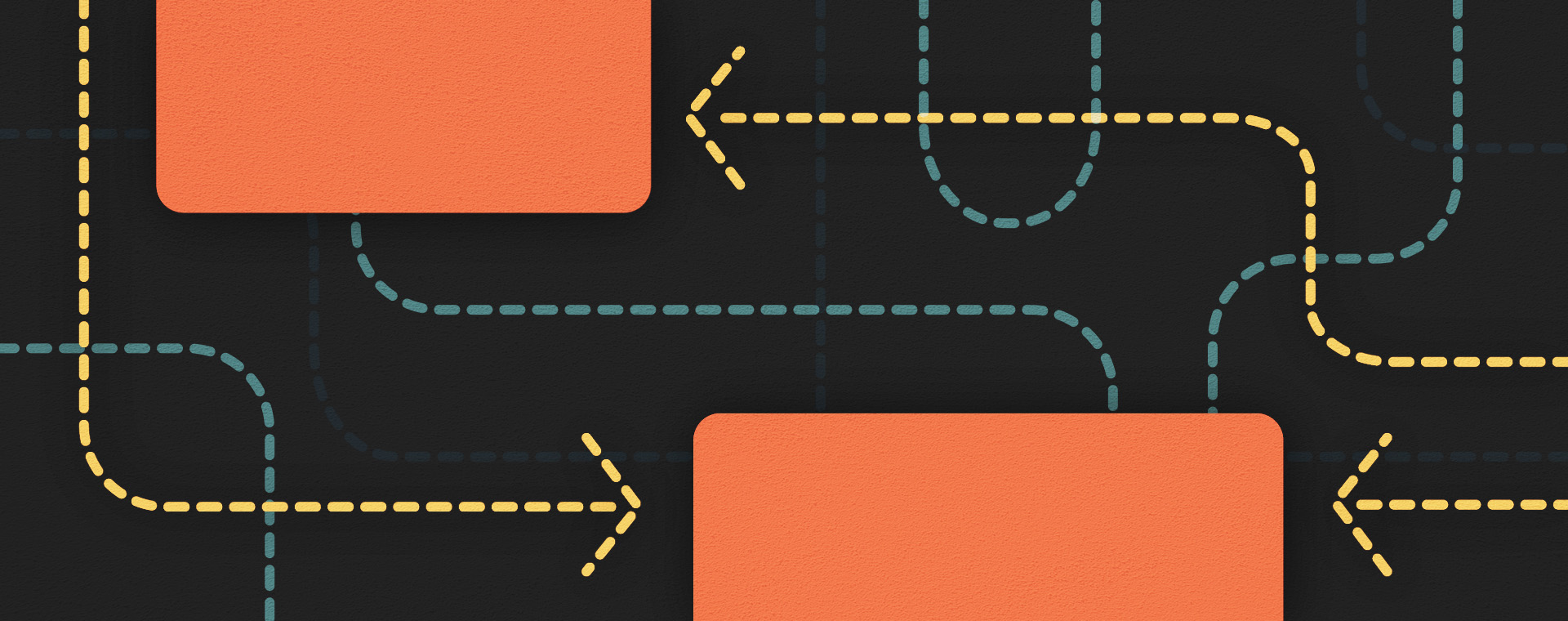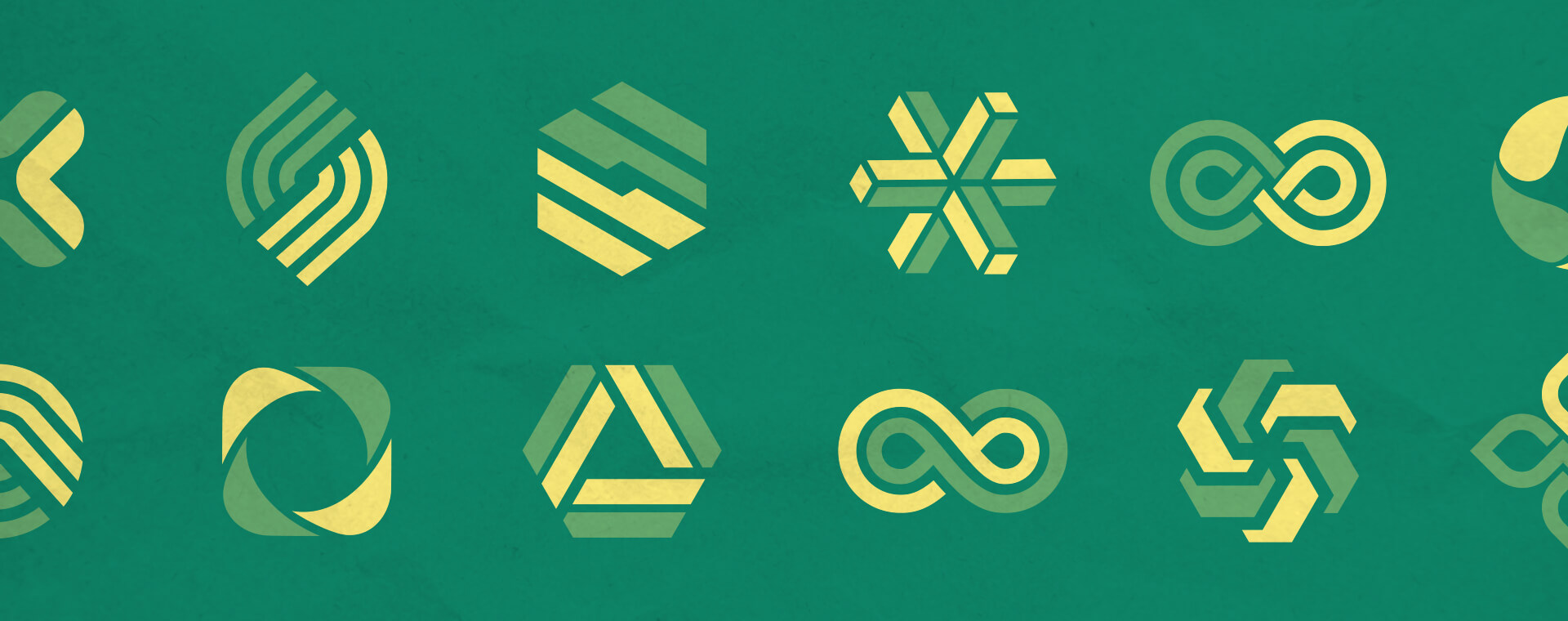Try these frameworks to prioritize your work (and become a better project manager)
By: Rachel Hickey
May 11, 2023 | Reading Time: 7 mins
So much to do, so little time! We’ve all experienced busy periods at work. Before you can even take your first sip of coffee, your to-do list is already a mile long—and everything is urgent. How can you manage it all?
If you want to become a better project manager, maximize productivity, and maintain a healthy work-life balance, you need to master the art of prioritization.
What is prioritization?
At its core, prioritization is about doing the things that are most important first—the things that maximize value. If you’re great at prioritization, you’ll be able to manage yourself, your team, and your projects better. When looking at a mile-long to-do list, your first thoughts may sound like this:
- Focus – Where do I want to focus each day?
- Tasks – What tasks are most important?
- Project – What projects need my attention?
- Emotional Energy – How do I want to spend my energy navigating people? Where do I need to exert more emotional energy?
These are great questions to start with! There are many ways to prioritize. As a Marketing Coordinator at a fast-paced digital marketing agency, I’ve seen how complex these decisions are. I’ve also witnessed the power of what can be achieved when your whole team is armed with healthy prioritization habits.
It’s tempting to leave all decision-making to top leaders, but every team member needs to be thinking about it. Prioritization should be everyone’s responsibility, all the time.
To control the chaos of a stacked to-do list and get your team on board, you need to build a mental framework so prioritization becomes a daily habit. Before you know it, decisions that were once complex will become easier to make.
Try these mental models for prioritization to become a better project manager, work faster, and avoid burnout
Impact vs. Effort Matrix
The Impact vs. Effort framework will help you answer the question “Is doing this task worth it?”. Ask yourself this when you need to weigh the effort against the outcome of completing the task. Should you reach for low-hanging fruit or build a ladder to reach the fruit at the top of the tree? The Impact Vs. Effort framework can help you identify the best ways to spend your precious time, money, and emotional energy so you see the fruits of your labour. 🍎

We like to use the Impact vs. Effort framework to identify quick wins for clients while de-prioritizing items that don’t drive value.
Do first: High-impact and low-effort tasks.
- These tasks are in the sweet spot. They are the quick, easy wins we want to knock out of the gate first and use them to build momentum!
- Example: You need to write a huge retrospective report. Get an outline in place to give yourself structure before untangling the data. The outline will help you focus and make reporting feel less daunting. It can enable you to delegate by splitting sections of the report among your team as well.
Do second: High-impact and high-effort tasks
- These tasks take a lot of energy, but they provide lots of value so should also be prioritized.
- Example: Building a capabilities deck for your professional services firm. This document requires deep thinking, collaboration, and design expertise but ultimately aligns all segments of your business making it a worthy effort.
Do third: Low-impact, low-effort tasks
- Usually aren’t a priority but are necessary (consider automating).
- Example: Responding to client communications, meetings, or housekeeping like cleaning up inboxes or dashboards. These routine tasks are easy to check off but don’t necessarily drive value. The more they pile up, then the more they may deter you from other tasks though, so consider how they can be automated for long-term gain. Try to utilize AI tools to liberate yourself from monotonous tasks, templatize where you can, automate reminders, etc.
Do last (or don’t do at all): High-effort, low-impact tasks.
- These tasks will drain your time, energy, and budget while giving you little in return. When you think about it this way, eliminating these tasks seems like a no-brainer.
- Example: Running campaigns on a platform your audience does not frequent.
Importance vs. urgency (The Eisenhower Matrix)
The Eisenhower Matrix is a helpful framework to answer “How soon should I do this task?”. Great for assessing your day-to-day workload, use this matrix to rank tasks by importance versus urgency, and make your decisions based on time. Despite what your manager or client says, not all tasks are important and not all tasks are urgent.

Important tasks contribute to long-term goals with clear benefits. These types of tasks propel or deter us from goals, impact profitability, have ethical implications, or impact alignment between stakeholders.
Urgent tasks call for immediate action. They can feel on fire with clear negative impacts turning up the heat. These tasks can impact upcoming deadlines, impact relationships, hurt subsequent stages of a project, or immediately impact other teams.
Based on urgency and importance, each task then falls into a time management category which dictates when it should be completed.
Do now: Urgent and important tasks.
- Example: Hard deadlines, unexpected emergencies, critical emails, removing blockers.
Plan for later: Not urgent, but still important tasks.
- Example: Items you know will be needed ahead of time, soft deadlines, training.
Delegate: Urgent and time-sensitive, but not important tasks.
- Example: Certain meetings, another team’s deadline, administrative tasks.
Don’t do it: Not urgent and not important tasks for your workday.
- Example: Things that are nice to have but not a need, items that span too far into the future.
Agile (MoSCOW Matrix)
There are many benefits of going agile, and prioritizing is one of them! The MoSCOW matrix is a great technique that answers the question, “What will bring the most value for the least amount of effort?”.

This matrix is a huge help to quickly bring your MVP (minimum viable product) to market. It focuses on iterative work that creates value throughout the lifecycle of a project. In other words, how can you get the earliest testable/usable/lovable thing out in the world?
“Many projects fail because they do Big Bang delivery (build the thing until 100% done and deliver at the end).”
– Hendrik Kniberg
Agile & Lean coach Henrik Kniberg has worked extensively with high-functioning teams like Spotify, LEGO, and even Minecraft to illustrate how going agile will give you the crucially needed feedback loop to give both you and the customer control over the project with agile design thinking. This mental model allows you to learn and make changes, instead of just following the most straightforward plan and hoping for the best.
We like to use the MoSCoW matrix to help us know when we have an MVP ready to go. To do this, we assign every task on our to-do list to one of four categories. Let’s use building a B2B professional services website as an example:
- M – Must Do: M tasks are things you absolutely have to do. (The website must be able to present your firm’s capabilities and expertise clearly).
- S – Should Do: S tasks are things you should do, but they’re a lower priority than M tasks. (The website should be user-friendly and easy to navigate).
- C – Could Do: C tasks are nice-to-dos. You’d like to do them, but if you don’t it’s probably not a big deal. (The website could have a social media feed feature or, complex animations).
- W – Won’t Do: W tasks are things that just aren’t worth doing. (The website won’t support video at this time as there is no video content).
With this mental model for prioritization, you prioritize the “must dos” and progressively reach your goal, all while getting setting yourself up for future improvements. It’s like how Henrik Kniberg illustrates agile development:
Ask yourself questions to build a habit of prioritization…
I know what you’re thinking—I’m already swamped, how can I make time to frame every decision into a diagram? You don’t! Mental models are about developing your thinking. Building a habit of prioritization requires you to further your thought process. It can be as simple as asking yourself a few questions each day to bring you focus. Try to think about these things the next time you are overwhelmed with your to-do list:
- Should I do this? Why or why not?
- Do I need to do this right now?
- Does doing this get me, my team, or my client closer to their goals?
- Will doing/not doing this be harmful to the project, my team, or stakeholders?
At the end of the day, prioritization is one of the most crucial tools our team uses for productivity as a professional services firm.
When you integrate models like these into your daily decision-making, you will form a habit so powerful it will give you a leading edge to bring your MVPs into the market faster. While everyone else gets sidetracked by competing priorities and still can’t decide on what to do first… you’ll already be off to the races.









